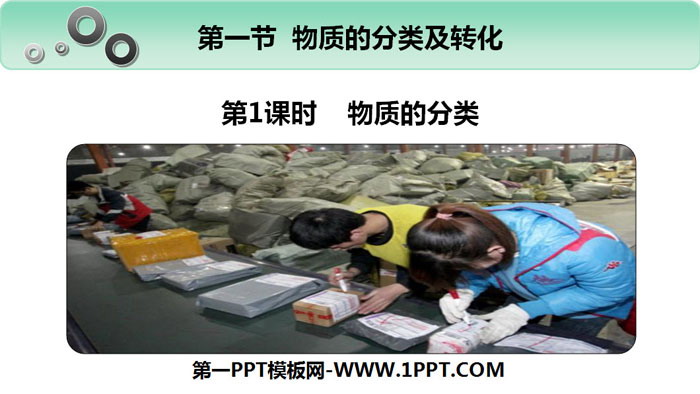
| Category | Format | Size |
|---|---|---|
| People's Education Press High School Chemistry Compulsory Course I | pptx | 6 MB |
Description
"Atomic Structure and Properties of Elements" Atomic Structure and Periodic Table of Elements PPT
Part One: Goals and Competencies:
1. Understand the relationship between atomic structure and element properties through the structural characteristics of alkali metal and halogen atoms. (Macroscopic identification and microscopic analysis)
2. Be able to initially use atomic structure theory to explain the similarity and variability of properties of alkali metals and halogens. (Changing concepts)
PPT on atomic structure and properties of elements, part 2: independent preview to explore new knowledge
1. The relationship between atomic structure and element properties
1. Metallic elements: The outermost electrons of atoms generally have less than , which are easy to ________ in chemical reactions and have ________.
2. Non-metallic elements: The outermost electrons of an atom generally have more than , which are easy to ________ in chemical reactions and have ________.
2. Alkali metal elements
1. Atomic structure of alkali metal elements
Conclusion: The common point of the atomic structures of alkali metal elements is ___________, and the difference is ___________. The changing pattern is that as the nuclear charge increases, the number of electron layers gradually___________, and the atomic radius gradually___________
(1) Comparison of reactions between sodium, potassium and oxygen
① Experimental phenomenon: Both burn in the air, sodium produces a yellow flame (observed through blue cobalt glass), potassium produces a purple flame, and potassium burns more violently.
②Reaction equation: 2Na+O2=====△Na2O2, K+O2=====△KO2.
3. Halogen elements
1. Physical properties of halogen elements
2. Atomic structural characteristics of halogen
Same point
① Halogen elements are located in group _____ of the periodic table;
②There are _____ electrons in the outermost shell.
gradation
From F→I, the number of nuclear charges increases in order, the number of electron layers increases in order _____, and the atomic radius increases in order _____
3. Chemical properties of halogen elements
(1) Reaction of halogen element and hydrogen
(2) Replacement reaction between halogen elements
1. Judge whether it is true or false (mark “√” if it is correct and “×” if it is wrong)
(1) Alkali metal elements are ⅠA elements ()
(2)K is more active than Na, so K can displace Na() from the sodium salt solution
(3) The reaction between halogen element and water can be expressed by X2+H2O===HXO+HX ()
(4) HX is highly soluble in water, and their thermal stability increases as the nuclear charge increases ()
2. Which of the following metals reacts most violently with water is ()
A. LiB. K.C. RbD. cs
D. Among alkali metals, as the number of electron layers of element atoms increases, the metal activity of alkali metals increases. Among the four options, the one that reacts most violently with water should be Cs. ]
Atomic structure and properties of elements PPT, the third part: core breakthroughs and difficult difficulties
Similarity and gradation of properties of alkali metal elements
1. Similarity (R represents alkali metal elements)
Atoms are prone to losing an electron in their outermost shell, and are chemically active. Their elements have strong reducing properties, and they can react with non-metallic elements such as oxygen and water. The general formula for the reaction between alkali metals and water is 2R+2H2O===2ROH+H2↑.
2. gradation
As the atomic number increases, the atomic radius gradually increases, the attraction of the atomic nucleus to the outermost electrons gradually decreases, the alkali metal element's ability to lose electrons gradually increases, and the metallicity gradually increases.
(2) The reaction with O2 becomes more and more intense, and the products become more complex. For example, the reaction of Li and O2 can only generate Li2O, the reaction of Na and O2 can also generate Na2O2, and the reaction of K and O2 can generate KO2, etc.
(3) The reaction with H2O becomes more and more violent. For example, K may explode slightly when reacting with H2O, and Rb and Cs may explode violently when meeting water.
(4) The alkalinity of the hydrate corresponding to the highest valence oxide gradually increases, and CsOH is the most alkaline.
[Typical example] Which of the following comparisons among the following groups is incorrect ()
A. Lithium reacts less vigorously with water than sodium with water
B. Reducibility: K>Na>Li, so K can replace metallic sodium from NaCl solution
C. Melting and boiling points: Li>Na>K
D. Alkaline: LiOH<NaOH<KOH
B [ Lithium in A is less reactive than sodium, and does not react as violently with water as sodium; B is reducing, K>Na>Li, but K cannot replace Na in the NaCl solution, but reacts with H2O first ;The melting and boiling points of alkali metal elements in C gradually decrease from Li to Cs, that is, Li>Na>K>Rb>Cs; from Li to Cs in D, the metallicity of alkali metal elements gradually increases, corresponding to the highest valence oxide The alkalinity of hydrates increases in sequence, that is, alkaline: LiOH<NaOH<KOH<RbOH<CsOH. ]
(1) Why are the chemical properties of alkali metal elements similar?
[ Tips Reacts with oxygen and other non-metals, water and acids.
(2) Why are the chemical properties of alkali metal elements degradable?
[Tips] There is a gradual change in the atomic structure of alkali metals. From Li to Cs, as the nuclear charge increases, the number of electron layers gradually increases, the atomic radius gradually increases, the attraction of the atomic nucleus to the outermost electrons gradually weakens, and the metallicity of the element gradually increases; therefore, the reducing properties of the element gradually increase, and the ions The oxidation property gradually weakens.
Atomic structure and properties of elements PPT, the fourth part: meeting standards in class and improving quality
1. The western region of my country is rich in lithium resources, and developing the use of lithium is an important scientific issue. Which statement about lithium is incorrect ()
A. Lithium is a lighter metal
B. LiOH is less alkaline than NaOH
C. Lithium is more metallic than sodium
D. Lithium burns in air to form Li2O
C: Lithium is less reactive than sodium. When burned in air, it only produces Li2O. LiOH is less alkaline than NaOH. Lithium is less metallic than sodium. Item C is incorrect. ]
2. In the order of fluorine, chlorine, bromine and iodine, which of the following statements is incorrect ()
A. The melting and boiling points of their elemental substances gradually increase
B. The atomic radius gradually increases, and the oxidation property of the element gradually increases.
C. The color of the simple substance gradually deepens
D. The stability of their gaseous hydrides gradually weakens
B[The melting and boiling points of fluorine, chlorine, bromine, and iodine gradually increase. A is correct; fluorine, chlorine, bromine, and iodine are all Group VIIA elements. From top to bottom, the atomic radii of the same main group gradually increase. increases, the non-metallic property gradually weakens, so the oxidation property of the element gradually weakens, B is wrong; the color of the elements of fluorine, chlorine, bromine and iodine gradually deepens, C is correct; non-metallic F>Cl>Br>I, non-metallic The stronger the hydride, the more stable the hydride, and the stability of their gaseous hydride gradually weakens, D is correct. ]
3. Which of the following statements about alkali metal elements is correct ()
A. Alkali metal elements are all silvery white and have a density less than water.
B. The melting points of alkali metal elements increase sequentially from Li to Cs
C. Cesium hydroxide is more basic than sodium hydroxide
D. The cations formed by alkali metal elements have increasing oxidizing properties from Li+ to Cs+.
C: Except for Rb and Cs, the density of the alkali metal elements is smaller than that of water. Cs has a slight metallic luster, and the others are silvery white. A is wrong. The melting points of the alkali metal elements decrease from Li to Cs. The reducing properties increase in sequence, the oxidizing properties of the formed cations decrease in sequence, and the alkalinity of the corresponding hydroxides increases in sequence. C is correct, and B and D are incorrect. ]
Keywords: Free download of the PPT courseware for high school chemistry compulsory course 1 of the People's Education Press, PPT download of atomic structure and properties of elements, PPT download of atomic structure and periodic table of elements, .PPT format;
For more information about the PPT courseware "Atomic Structure and Periodic Table of Elements Atomic Structure and Properties of Elements", please click the Atomic Structure and Periodic Table of Elements ppt Atomic Structure and Properties of Elements ppt tag.
"Atomic Structure and Periodic Table of Elements" Periodic Law of Material Structure PPT (Lesson 2 Atomic Structure and Properties of Elements):
"Atomic Structure and Periodic Table of Elements" Periodic Law of Material Structure Elements PPT (Lesson 2 Atomic Structure and Properties of Elements) Part One Content: Learning Objectives Course Standards 1. Understand the properties of alkali metal elements and halogen elements and their placement in the periodic table of elements relationship between the central position. ..
"Atomic Structure and Periodic Table of Elements" Periodic Law of Elements in Material Structure PPT (Lesson 1 Atomic Structure and Periodic Table of Elements Nuclides):
"Atomic Structure and Periodic Table of Elements" Periodic Law of Material Structure Elements PPT (Lesson 1 Atomic Structure Periodic Table Nuclides) Part One Content: Learning Objectives Course Standards 1. Understand the electron arrangement outside the nucleus. 2. Know the structure of the periodic table of elements. 3. Know..
"Atomic Structure and Properties of Elements" Atomic Structure and Periodic Table of Elements PPT Download:
"Atomic Structure and Properties of Elements" Atomic Structure and Periodic Table PPT Download Part One: Literacy Objectives 1. Know the atomic structure and characteristics of alkali metal elements and halogen elements through the atomic structure and atomic radius information in the textbook tables. 2. Through teaching materials..
File Info
Update Time: 2024-06-27
This template belongs to Chemistry courseware People's Education Press High School Chemistry Compulsory Course I industry PPT template
"Atomic Structure and Properties of Elements" Atomic Structure and Periodic Table of Elements PPT Simple campus recruitment activity planning plan summary enterprise and institution recruitment publicity lecture PPT template is a general PPT template for business post competition provided by the manuscript PPT, simple campus recruitment activity planning plan summary enterprise and institution recruitment promotion Lecture PPT template, you can edit and modify the text and pictures in the source file by downloading the source file. If you want more exquisite business PPT templates, you can come to grid resource. Doug resource PPT, massive PPT template slide material download, we only make high-quality PPT templates!
Tips: If you open the template and feel that it is not suitable for all your needs, you can search for related content "Atomic Structure and Properties of Elements" Atomic Structure and Periodic Table of Elements PPT is enough.
How to use the Windows system template
Directly decompress the file and use it with office or wps
How to use the Mac system template
Directly decompress the file and use it Office or wps can be used
Related reading
For more detailed PPT-related tutorials and font tutorials, you can view: Click to see
How to create a high-quality technological sense PPT? 4 ways to share the bottom of the box
Notice
Do not download in WeChat, Zhihu, QQ, built-in browsers, please use mobile browsers to download! If you are a mobile phone user, please download it on your computer!
1. The manuscript PPT is only for study and reference, please delete it 24 hours after downloading.
2. If the resource involves your legitimate rights and interests, delete it immediately.
3. Contact information: service@daogebangong.com
"Atomic Structure and Properties of Elements" Atomic Structure and Periodic Table of Elements PPT, due to usage restrictions, it is only for personal study and reference use. For commercial use, please go to the relevant official website for authorization.
(Personal non-commercial use refers to the use of this font to complete the display of personal works, including but not limited to the design of personal papers, resumes, etc.)
Preview





















